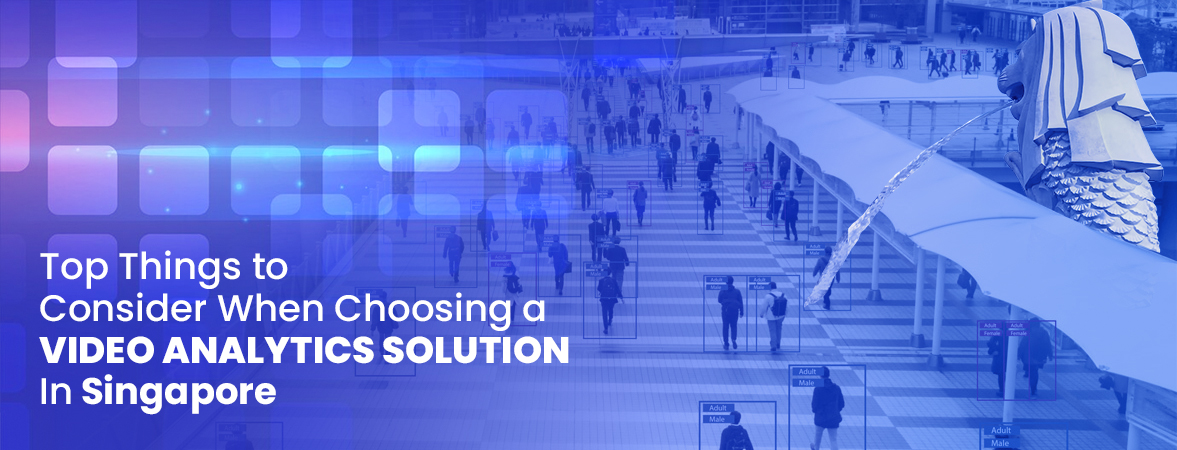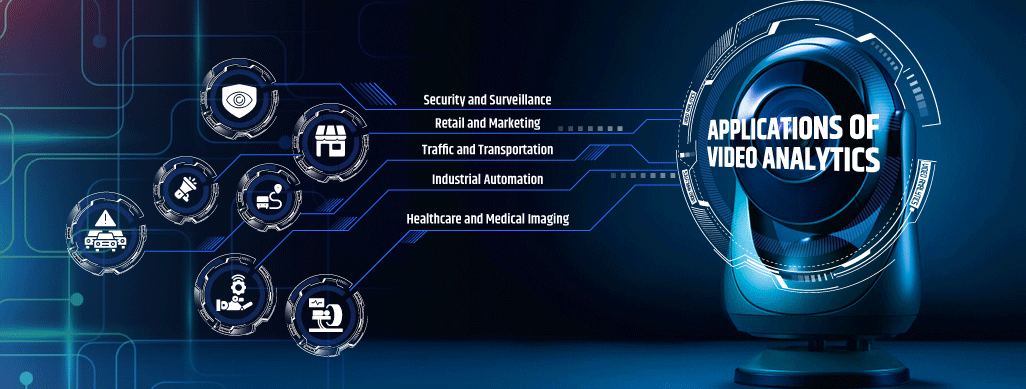
We use cookies to ensure that we give you the best experience on our website.
By using this site, you agree to our use of cookies. Find out more.
This blog discusses the key things you need to consider when selecting a video analytics solution for your needs in Singapore. We will first explain what video analytics is and explore some common applications like security, retail, traffic management, industrial automation and healthcare.

Video analytics is a growing field with many valuable applications in Singapore. As the use of surveillance cameras and video monitoring expands across various industries, organizations are looking to leverage video analytics to gain valuable insights. However, choosing the right video analytics solution can be challenging as there are many options available in the market.
This blog discusses the key things you need to consider when selecting a video analytics solution for your needs in Singapore. We will first explain what video analytics is and explore some common applications like security, retail, traffic management, industrial automation and healthcare. Finally, we outline the important criteria to evaluate like security, integration, functionality, scalability, deployment and compliance, to ensure you pick a product that meets your current and future requirements.
Video analytics refers to the analysis of video footage through application of computer vision, image processing and artificial intelligence techniques. Using algorithms, video analytics systems can automatically analyze live or recorded video streams to extract insights and information. The core capabilities include object detection, classification and tracking. For example, it can detect people, vehicles or other objects and track their movement across the frames.
Advanced analytics functions include estimation of crowd density, detection of left behind items, identification of suspicious behavior and recognition of known persons. All of this is done in real-time or through off-line analysis of stored videos. The computational capabilities that were not possible with traditional CCTV systems allow automated analysis and interpretation of videos for a wide range of applications.
Here are some key applications of video analytics:

Security and Surveillance
One of the most common applications of video analytics is for security and surveillance purposes. It allows organizations to automatically detect suspicious activities or behaviors in video footages. Functions like loitering detection, left object/item detection and crowd movement analysis help improve safety and security. Video analytics integrated with alarms and notifications enhance monitoring and response capabilities.
Retail and Marketing
In retail, video analytics provides valuable customer insights. Functions like customer counting, queue management and heat mapping help optimize operations and plan floor layouts. It can also analyze customer demographics, engagement with products and conversion rates. This assists with marketing strategies and improving the shopping experience. Features like facial recognition while preserving anonymity are increasingly being used.
Traffic and Transportation
When deployed at intersections, highways and toll booths, video analytics helps optimize traffic flow. It detects congestion, violations and accidents to enable better traffic management. Public transport systems also use it to analyze passenger queues, loads and dwell times to improve operational efficiency. Pedestrian counting and crowd flow analysis further assists with urban planning.
Industrial Automation
In industrial settings, video analytics automates inspection and quality control tasks. It identifies defects, checks for compliance to procedures and detects anomalies on production lines and in warehouses. This increases productivity while maintaining quality standards. Functions like asset tracking and geo-fencing enhance equipment monitoring and security. It�s also useful for analyzing industrial processes, safety incidents and performance metrics.
Healthcare and Medical Imaging
Within healthcare, video-based remote monitoring and Virtual ICU capabilities are valuable applications. Video analytics extracts diagnostic data from scans and videos of patients. It assists with treatment management by monitoring patients, detecting falls and quantifying symptoms over time. While preserving privacy, it also helps optimize hospital resources, staff allocation and clinical workflows.
Here are some important things to consider when choosing video analytics companies in Singapore:
With video analytics solutions increasingly being connected to the internet and storing large volumes of sensitive surveillance data, cybersecurity should be the top priority when evaluating different options. It is crucial to carefully scrutinize the security capabilities and practices of different vendors. The system should incorporate robust access controls, strong authentication methods, regular vulnerability scanning and patches.
Data transmissions and storage should be encrypting using robust protocols. Look for solutions that have undergone independent security audits and carry certifications like ISO 27001. Also consider the vendor's track record - does the company promptly address any security issues found in their products? Avoid choosing products that already have a history of data breaches or unpatched exploits. Thoroughly assessing these security controls upfront can help ensure your video data, systems and organizational networks remain well protected from the ever-evolving threat landscape.
When selecting video analytics companies in Singapore, it is important to carefully consider integration capabilities. Ease of integration will ensure a seamless deployment and help maximize return on investment.
Key things to evaluate include checking that the solution is compatible with your current IP camera makes and models as well as video management systems. It is also beneficial if the software can integrate with other organizational systems like access control, building management solutions or enterprise applications via APIs. This fosters synergy across security and business operations.
Look for platforms that offer ready integrations or smooth custom integration processes. Plug-and-play solutions require less custom coding and configuration. Easy integration means the system can be up and running promptly without disrupting ongoing surveillance or other technical workflows. Overall integration, interoperability and scalability are crucial for timely and cost-effective deployment.
When choosing a video analytics system, it is important to start by making a list of essential requirements and desired capabilities. Clearly identifying core needs helps narrow down options to those best suited. For example, essential functions could be people counting for maximum occupancy monitoring or left object detection for unattended baggage alarms.
On the other hand, facial recognition may be desirable for additional security but not critical. This separates must-have from nice-to-have features. It ensures investing in a future-proof solution without overspending unnecessarily in the initial phase. As budgets allow later, more advanced functionalities can be enabled. This staged approach protects upfront costs while keeping options open.
Do assess provider roadmaps too to ensure core required functions will remain supported long-term. Overall, distinguishing priorities from secondary wants ensures a tailored purchase meeting operational needs cost-effectively both now and as requirements evolve.
As organizations expand operations over time, it is important to select video analytics companies in Singapore capable of scaling up to future needs. The solution should be offered in a modular way that allows adding more cameras, storage capacity, analytics capabilities or advanced AI functions as demand increases.
Look for platforms featuring regular software updates, large ecosystem of integrated partners, and flexible licensing and purchase options. This protects investments made today from becoming obsolete down the road. A scalable system future-proofs against unexpected changes like facility expansions, new technology integrations or revised security strategies. It spares costly system overhauls or migrations later.
When evaluating vendors, scrutinize their roadmap vision and ability to support evolving requirements through a long product life cycle. This ensures capital outlay on security solutions creates long-lasting value and allows harnessing analytics to maximum effect as the business grows.
Different organizations may prefer diverse deployment architectures depending on their infrastructure, IT expertise, connectivity and compliance needs. Consider your environment and requirements carefully to pick the most appropriate model. Options include fully on-premise, cloud-hosted, or hybrid deployments.
On-premise is best if you have robust in-house servers, unlimited bandwidth and full data sovereignty is essential. Cloud deployment is low maintenance but relies on a stable internet connection. Hybrid model strikes a balance, keeping sensitive data on local servers while using cloud for flexible scaling. Ask vendors about reliability, response times, data ownership, upgrade policies and support offerings for each option.
Also assess IT skills available and costs of in-house servers versus subscription fees. Choosing the right deployment avenue safeguards budget, speeds deployment and frees internal teams from ongoing system management. This ensures seamless operations suited precisely to your organizational context.
When deploying a video analytics system that involves large-scale surveillance and analysis of personal data, ensuring compliance with privacy regulations is crucial. Solutions should incorporate robust security controls like access logs, authorization for data access, and automatic deletion policies to meet data retention limits.
Vendors must be transparent about how data is collected, stored, secured and shared. Look for products that anonymize faces and offer encrypted streaming/recording in line with laws like PDPA. Clarify whether you or the vendor owns the recorded data. Data should only be processed for the original intended purpose too. Check if the provider adheres to third-party audits and security certifications.
Non-compliance can result in huge fines and reputational damage. By prioritizing privacy during selection, you lay the foundation for a system that lawfully addresses security needs while respecting individuals' rights over their information.
In conclusion, video analytics provides many benefits but also requires cautious evaluation due its involvement of sensitive surveillance data. Taking the time to fully understand your priorities and assess vendors based on the considerations outlined here puts you in a good position to choose a secure, cost-effective and future-proofed solution. Do not compromise on critical aspects like cybersecurity and privacy. Also ensure seamless integration and a deployment model catering to your infrastructure. With a well-researched selection anchored on clear needs, organizations can leverage video analytics to enhance safety, operations and business intelligence in Singapore. Following these best practices leads to maximizing returns from this powerful and growing technology.
Leave a Comment
Your email address will not be published.